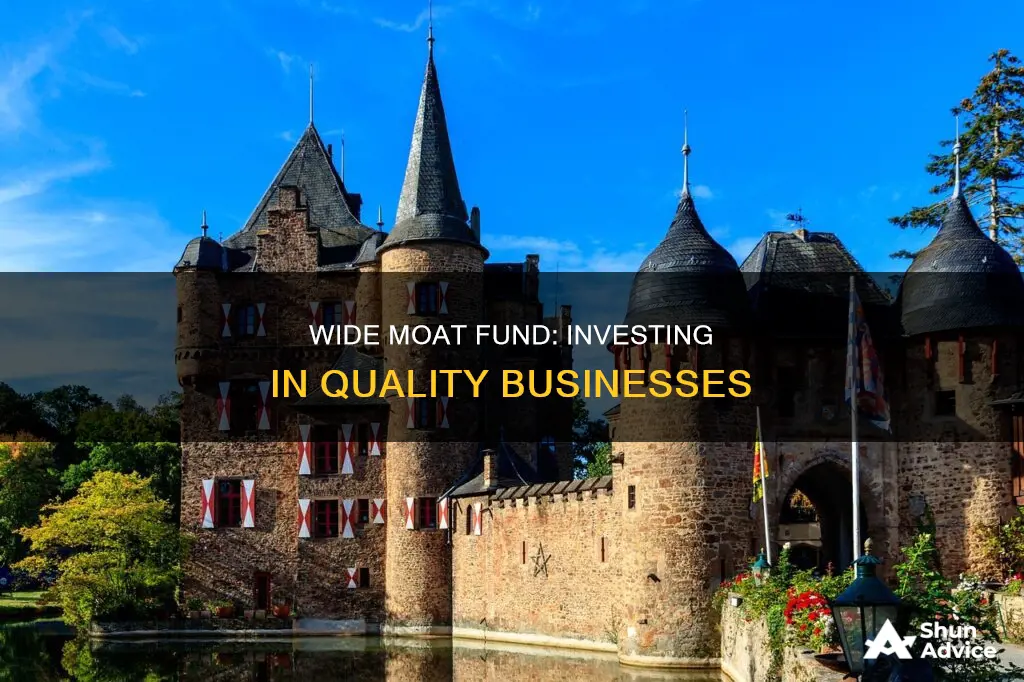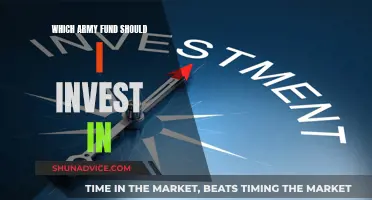
Wide moat stocks are companies that have significant competitive advantages that allow them to outperform their competitors and maintain high profitability and returns on capital. These advantages can be in the form of superior brands, pricing power, or operational advantages. Wide moat companies are often larger in size and display higher profitability, making them attractive investments for long-term investors. The concept of investing in these companies was popularised by Warren Buffett, CEO of Berkshire Hathaway, who described the importance of identifying a moat when investing. Wide moat stocks can be found by evaluating a company's financial information, such as earnings predictability, return on equity, and return on total capital.
What You'll Learn

Wide moat stocks: what they are and how to identify them
Wide moat stocks are companies believed to have significant competitive advantages that allow them to outperform their peers and maintain high profitability and returns over the long term. These advantages are often referred to as a "moat", reflecting the fortified market position of these companies.
There are several ways in which a company can create a moat:
- Superior brand: A strong brand identity can make it difficult for customers to switch to competitors. An example is Apple Inc., where the ecosystem keeps users locked in.
- Pricing power: Some companies can produce goods at a lower cost than their competitors, allowing them to offer lower prices.
- Operational advantages: This could include territorial distribution or production rights, or having a product that is widely used by customers, making it hard for them to switch to alternatives.
- High switching costs: When a company's products or services have high switching costs, customers are less likely to switch to competitors.
- Low-cost producer: Some companies can produce goods and services more cost-effectively than their competitors, increasing their profit margins.
- Intangible assets: Patents, superior technology, greater talent, or a unique corporate culture can create a competitive advantage.
- Efficient scale: Industries dominated by a small number of companies benefit from efficient scale and can be more profitable.
- Network effect: The value of a company's product or service increases as more people use it. For example, Amazon has a wide moat due to the popularity of its platform and its ability to maintain its advantage through its vast distribution network.
When identifying wide moat stocks, it is important to look for companies with consistently increasing earnings over a long period, typically a decade or more. Additionally, it is crucial to assess the level of profitability by evaluating metrics such as return on equity (ROE) and return on total capital (ROTC) over time.
Some examples of wide moat stocks include Meta Platforms, Amazon, Alphabet, Comcast Corporation, and Gilead Sciences. Wide moat stocks can be excellent long-term investments, but it is important to consider that they may have premium valuations, and there is a risk of share price decline if the moat is not defended effectively.
Hedge Fund Investing in Singapore: A Comprehensive Guide
You may want to see also

Examples of wide moat stocks
Wide moat stocks are stocks that have the potential to outperform in the long term. They are companies with a competitive advantage that protects their market share and profitability. This advantage can be due to a variety of factors, including brand recognition, pricing power, operational advantages, high barriers to entry, and more.
- Walmart (WMT): Walmart has an immense volume of sales and negotiates low prices with its suppliers, resulting in low-cost products that are hard for competitors to match.
- Autodesk (ADSK): Autodesk offers software solutions for engineers and designers that are very complex and time-consuming to learn. Once a customer starts using Autodesk's software, they are unlikely to switch, allowing the company to charge premium prices.
- Pharmaceutical companies: Pharmaceutical companies often have patented drugs, which gives them a competitive advantage as they have exclusive rights to produce and sell these drugs.
- Amazon (AMZN) and eBay (EBAY): These companies benefit from the network effect, where their products become more valuable as more people use them. This makes it difficult for customers to switch to other platforms.
- Tyler Technologies Inc: Tyler Technologies is one of the 10 most undervalued wide-moat stocks according to Morningstar.
- NXP Semiconductors (NXPI): NXP Semiconductors is another company on Morningstar's list of undervalued wide-moat stocks.
Schwab Fund Investment: A Beginner's Guide to Getting Started
You may want to see also

The importance of management for wide moat companies
Management plays a crucial role in the success of wide moat companies, which are businesses with strong competitive advantages that protect their market position and profitability over the long term. While the existence of a wide moat is a significant factor in a company's success, exceptional management further strengthens a company's position and enhances its ability to maintain and expand its moat.
Effective management is particularly important when considering investments in wide moat companies. While a company with a strong competitive advantage may initially attract investors, the quality of its management team will influence its ability to maintain and expand its market position over time.
When evaluating wide moat companies, it is essential to consider the management's ability to allocate capital effectively, make strategic acquisitions, and adapt to evolving market conditions. For example, mergers and acquisitions can be a double-edged sword, as they may either strengthen or weaken a company's competitive position, depending on the management's skill in identifying and integrating suitable targets.
Additionally, wide moat companies often operate in dynamic industries where market conditions and competitive dynamics can change rapidly. A competent management team will be able to navigate these shifts and make strategic decisions that reinforce the company's moat. This may involve investing in research and development, strengthening brand recognition, or leveraging network effects to solidify the company's market position.
In summary, while the existence of a wide moat is an important indicator of a company's competitive advantage, the quality of management is a critical factor in maintaining and expanding that advantage over time. Effective capital allocation, strategic acquisitions, and adaptability to market changes are key aspects of management competency that can significantly impact the long-term success of wide moat companies.
India's Alternative Investment Funds: Exploring the Options
You may want to see also

How to calculate if a company has a wide moat
A wide moat is a type of unique competitive advantage a company holds over its industry rivals. The concept of investing in companies with durable competitive advantages was popularised by Warren Buffett, CEO of Berkshire Hathaway, who is considered one of history's best investors.
Buffett's approach to investing focuses on finding a business with a "wide and long-lasting moat" that protects its economic castle. Companies with wide moats typically have above-average profitability and face constant competition, so they must continuously work to improve their moats.
- Earnings predictability: Earnings need to be very predictable, consistently increasing over a minimum of a decade. This shows that the business's profits are steadily increasing, giving confidence in its future earnings power. By examining profits over a long period, you can also assess how the company performed during economic downturns and if it remained profitable during recessions.
- Return on Equity (ROE): This measures net income over total equity. A higher ROE is better. An investor can compare ROE over time to see if returns are above average or increasing over a ten-year period.
- Return on Total Capital (ROTC): ROTC measures net income over total capital, including debt. This metric considers a company's capital structure and its use of debt. Similar to ROE, an investor can examine ROTC over time to identify if returns are above average or increasing.
- Intangible Assets: These include fanatically loyal customers, superior brand strength, patents, superior technology, greater talent, or an unmatched corporate culture.
- Customer Switching Costs: Products or services that are not easily abandoned for a competitor's offering.
- Cost Advantage: Achieved through meaningful economies of scale and demonstrated by over a decade of healthy operating and profitability ratios.
- Network Effect: Networks that become more useful as more people join. Companies that benefit from this effect tend to have massive reach and scale.
- Efficient Scale: Monopolies that exist for efficiency purposes, with consistent positive free cash flow and dividend payouts.
While wide moat investing can be powerful, it's important to acknowledge that some companies with competitive advantages may not be profitable in the short run as they aggressively reinvest in their business to build or protect their moat. Additionally, companies with wide moats often have premium valuations, and those that can't defend their moats may see their share prices fall over time.
A Guide to Investing in L&T Mutual Funds
You may want to see also

Where to find wide moat companies
Wide-moat companies are those that have significant competitive advantages that allow them to fight off competition and maintain high profitability and returns on capital. A moat can come in several forms.
Some companies create moats through a superior brand. Others do it via pricing power that competitors can't match. Still, others do it through operational advantages, such as lower production costs.
Some tell-tale signs of a wide-moat company include:
- Consistent profitability throughout the economic cycle
- High returns on capital thanks to strong pricing power and a loyal customer base
- Steadily increasing earnings and free cash flow over many years
- Little need for external capital to fund growth
- Meaningful “insider ownership” by management whose interests are aligned with shareholders
Some sources of moats include:
- Intangible assets like strong brand names, patents or regulatory licenses
- High switching costs that make it expensive or inconvenient for customers to stop using a company’s products
- Network effects that make a service more valuable as more people use it
- Cost advantages stemming from superior processes, unique assets or large scale
- Efficient scale in a niche market that can only support one or a few competitors
The Morningstar Wide Moat Focus Index is a good place to start looking for wide-moat companies. This index tracks companies that have been given Morningstar Economic Moat Ratings of 'wide' and whose stocks are trading at the lowest current market prices relative to their fair value estimates.
Some wide-moat companies added to the Morningstar Wide Moat Focus Index include:
- Air Products and Chemicals
- Bio-Rad Laboratories
- Emerson Electric
- GE Healthcare Technologies
- Huntington Ingalls Industries
- Idex Corporation
- NXP Semiconductors
- United Parcel Service
A Beginner's Guide to Investing in Kotak Mutual Funds
You may want to see also
Frequently asked questions
Wide moat funds invest in a variety of stocks that have the potential to outperform over the long term. These stocks are typically from companies with significant competitive advantages that allow them to fight off competition and maintain high profitability and returns on capital.
Some examples of wide moat stocks include Amazon, Walmart, Meta Platforms, Alphabet Inc., and Comcast Corporation.
When choosing a wide moat ETF, it is important to consider the methodology of the underlying index, the performance of the ETF, and other factors such as size, cost, age, income, domicile, and replication method.







